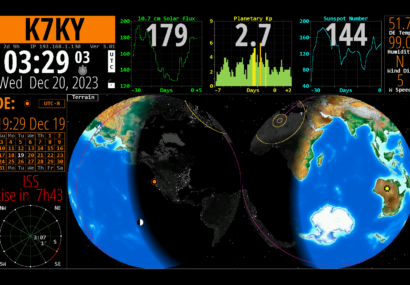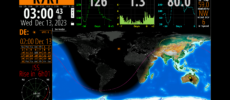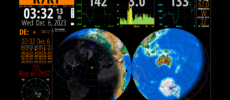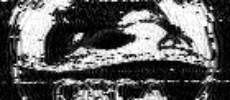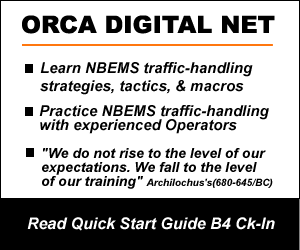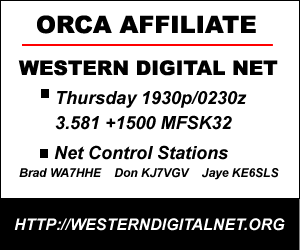ORCA DIGITAL NET, Report 13Jan15
Check-ins: 9
Traffic: 7
Stations:
WA6NBG Don T
KW6JIM Jim T
KB6NN Howard T
KA6ULG Bob mon
KI6RIT Nick T
KE6SLS Jaye kbd
K7IFG Ken T
W7ZAP Mindy T
K7KY Doug NCS T
Despite poor band conditions, the net went very nicely. It was longer than usual due to our first experience with FLAMP. Although a number of stations had previously used it successfully, we didn’t succeed with reception REPORTS and sending fills. Still, there were more stations ready for FLAMP than I anticipated and I think we’ll have it operational quickly. It was again difficult to hear all stations on 3.955 ssb. The background noise in Brookings was S8-9 and we had a strong adjacent station. I could hear Howard, but not understand him. Thanks to KW6JIM for relaying. Actually, this is a condition we’ll want to address. There will always be times when some stations are hard to hear. Winter band can be very noisy and some stations have HOA antennas. We want to relay these stations w/o disrupting ongoing net activity if we can. KW6JIM relayed KB6NN in the voice portion and Mindy could read Howard digitally when I could not, so I knew he was there. When we need to relay longer messages, it might be a good idea to make that contact at 2200 on the WF while the net continues at 1500. My power was 100w ssb and 30w data. I usually use 35w ssb and 20w data, but winter conditions require more power.
Jim sent an interesting ICS-213 message about a balloon beacon made of party balloons. I hope it floats by here; I’d like to hear it. Good to have Nick KI6RIT back after the holidays. And, Jaye KE6SLS was with us too. Jaye has obviously spent some time exploring FLDIGI and knows his way around the app very well. He touched on a topic on my horizon: controlling the rig with FLDIGI. I also want to try the logging feature when I have time. Jaye also noted an improvement in our net protocol. His perspective is refreshing for me; I don’t always notice the small advances we make every week. These advancements are due mainly to the experience and expertise of our members. Many of these Ops live in Humboldt County where there seems to be more interest in the digital modes than usual. We missed one of our regular Ops, Danon KJ6UPE was busy preparing for next week’s Humboldt County emergency drill.
During our FLAMP experiment, Ken K7IFG suggested configuring FLAMP to send the message header twice. That sounds like a good idea. We’ll be better prepared with FLAMP next time.
I’ve been visiting the IDAHO ARES/RACES DIGITAL NET lately where I see Ken K7IFG check in too. It also meets on Tuesdays: 0230z – 1800p, 3.578mhz, PSK-31. They seem to have multiple NCS. I’ve met two, Mike WB7RBH and Marlene KF6YNC. It’s a friendly net and operates digital only, no voice. They advertise 3.5785 as net freq, but it puts their signal near the edge of the passband and I tune them at 3.578 to move the signal closer to the center. I’ve been connecting with them at 5w. It’s interesting to visit other digital nets and I’d like to know of other digital nets you may be visiting.
It has me wondering if we should revisit a digital-only net protocol. I like the speed with which we communicate on voice, but it does raise the bar for ease-of-participation. Maybe we can develop a better digital check-in scheme using Ken’s suggestion for breaking into the ongoing net with brief tuning signals. Once configured, printing your callsign quickly on the waterfall can be done with one click on the ID/Video tab. Another click turns it off. We’ll demonstrate this next Tuesday. It may not be the solution for checking in digitally, but it might be useful otherwise. Here, a note to myself. I forgot to check for late/visitors during digital rotation. Trying to minimize idle time, I don’t always remember to leave a few moments for break-ins or give them a call.
And, my sincere apology for more NCS callsign errors. I feel bad when I mistake anyone’s callsign and especially my longest net colleagues like WA6NBG and KW6JIM. Just when I thought I’d fixed all my macros, I find the new version of FLDIGI has gone back to it’s roots and loaded an old macro file. I store all non-app data on D: drive and FLDIGI defaults to ‘C:\Documents & Settings\…,.’. I can’t blame it all on the macros; I sometimes mistype them on the kbd. At times, my attention is completely occupied and my internal error-checking is disabled. Now, I’ve deleted all old macro files from everywhere! May it never happen again….
Also, we’re very close to completing the ORCA website. We have a couple programming issues not yet resolved and Mindy is deep into the intermediate CW Academy class. I’m auditing the advanced class that I took last year. The homework takes a lot of time and it cuts into our web/dev time.
Sorry, no ORCA net log this week. After the net, I went to eat before copying the log and when I returned, FLDIGI was NOT-RESPONDING. No hope for the net log. Next time, I’ll copy it directly after net.
Thanks to everyone who participated in the net. Your participation and input is the foundation of the net. We’ve really come a long way together and the net is smoother and more engaging. I hope to see you all next week. 73 Doug K7KY
